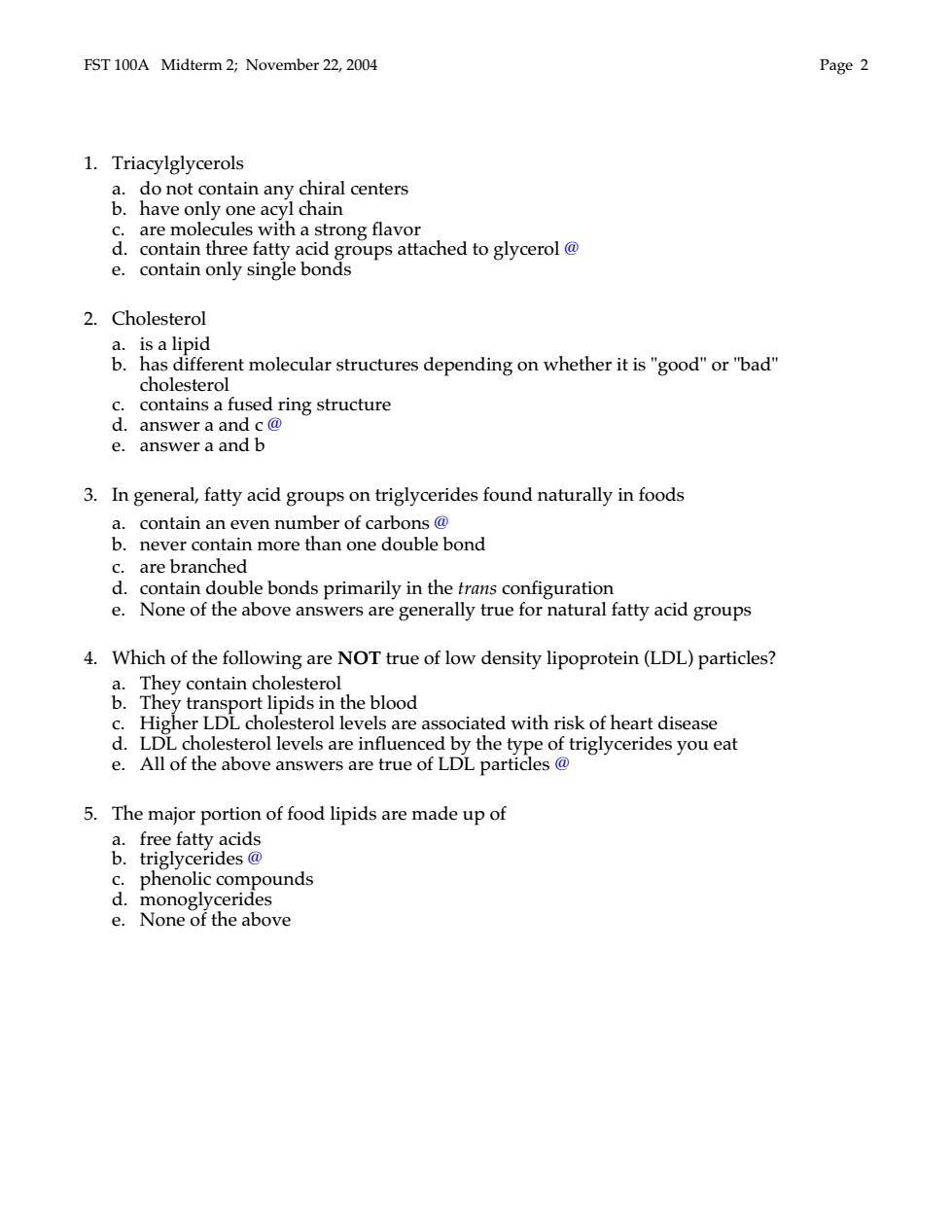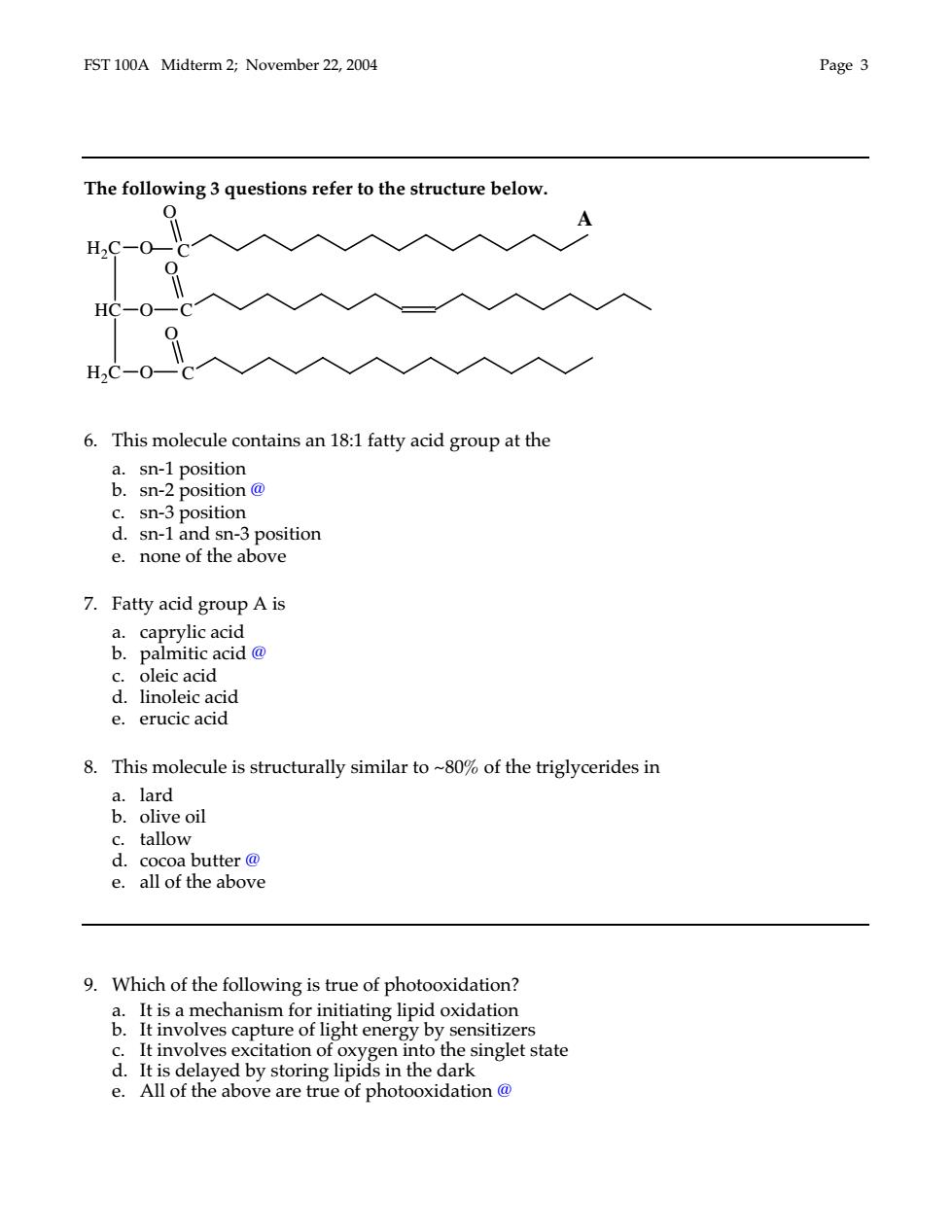
Food Science Technology 100A Professor S.R.Dungan Second Midterm Examination November 22,2004 Version A Name:KEY Last First Signature: INSTRUCTIONS PRINT your last and first names above.Then SIGN the exam copy. PRINT your name on the front of your Scantron #2000. WRITE the test version that appears at the top of this page on your Scantron00. WRITE your student identification number in the appropriate area of your Scantron #2000 on Part 1 and follow the instructions to CODE your ID number in the bubbles. CHECK that there are 36 multiple choice questions.There are a total of 11 pages to the exam. your Scantron Please respect the UC Davis Honor Code in the taking of this exam. There should be plenty of time to take this exam without being rushed.However,you will need to use your time efficiently. Graded exams can be picked up in 110 FSTB. Multiple Choice /90 /10 answers Total 100
Food Science & Technology 100A Professor S.R. Dungan Second Midterm Examination November 22, 2004 Version A Name:KEY Last First Signature: INSTRUCTIONS PRINT your last and first names above. Then SIGN the exam copy. PRINT your name on the front of your Scantron #2000. WRITE the test version that appears at the top of this page on your Scantron #2000. WRITE your student identification number in the appropriate area of your Scantron #2000 on Part 1 and follow the instructions to CODE your ID number in the bubbles. CHECK that there are 36 multiple choice questions. There are a total of 11 pages to the exam. Use a #2 pencil to mark your Scantron answers. You are responsible for the accuracy and completeness of your Scantron. Do not put any marks (other than filling in the answer bubbles) on the left side(s) of the Scantron sheet. Please respect the UC Davis Honor Code in the taking of this exam. There should be plenty of time to take this exam without being rushed. However, you will need to use your time efficiently. Graded exams can be picked up in 110 FSTB. Multiple Choice /90 Short answers / 10 Total 100

FST 100A Midterm 2;November 22,2004 Page2 1.Triacylglycerols a.do not contain any chiral centers b.have only one acyl chain c.are molecules with a strong flavor d.contain three fatty acid groups attached to glycerol@ e.contain only single bonds 2.Cholesterol a.is a lipid b.has different molecular structures depending on whether it is"good"or"bad" cholesterol 且in e.answer a and b 3.In general,fatty acid groups on triglycerides found naturally in foods &.aenaomsmmoeahnioiceatbobieRond c are branched e None ration 4.Which of the following are NOT true of low density lipoprotein(LDL)particles? inids in the blood LDL choleste ol levels are associated with risk of heart disease d.LDL cholesterol levels are influenced by the ty e.All of the above answers are true of LDL particles 5.The major portion of food lipids are made up of z acids c.phenolic compounds d.monoglycerides e.None of the above
FST 100A Midterm 2; November 22, 2004 Page 2 1. Triacylglycerols a. do not contain any chiral centers b. have only one acyl chain c. are molecules with a strong flavor d. contain three fatty acid groups attached to glycerol @ e. contain only single bonds 2. Cholesterol a. is a lipid b. has different molecular structures depending on whether it is "good" or "bad" cholesterol c. contains a fused ring structure d. answer a and c @ e. answer a and b 3. In general, fatty acid groups on triglycerides found naturally in foods a. contain an even number of carbons @ b. never contain more than one double bond c. are branched d. contain double bonds primarily in the trans configuration e. None of the above answers are generally true for natural fatty acid groups 4. Which of the following are NOT true of low density lipoprotein (LDL) particles? a. They contain cholesterol b. They transport lipids in the blood c. Higher LDL cholesterol levels are associated with risk of heart disease d. LDL cholesterol levels are influenced by the type of triglycerides you eat e. All of the above answers are true of LDL particles @ 5. The major portion of food lipids are made up of a. free fatty acids b. triglycerides @ c. phenolic compounds d. monoglycerides e. None of the above

FST 100A Midterm 2;November 22,2004 Page 3 The following 3 questions refer to the structure below. 0 A H2C-0- 9 H2C-0 6.This molecule contains an 18:1 fatty acid group at the &ma。 c.sn-3 position d.sn-1 and sn-3 position e.none of the above 7.Fatty acid group A is palmitic acid 8.This molecule is structurally similar to~80%of the triglycerides in a.lard b.olive oil c.tallow d.cocoa butter@ e.all of the above 9.Which of the following is true of photooxidation? en into the singlet state e.All of the above are true of photooxidation@
FST 100A Midterm 2; November 22, 2004 Page 3 The following 3 questions refer to the structure below. 6. This molecule contains an 18:1 fatty acid group at the a. sn-1 position b. sn-2 position @ c. sn-3 position d. sn-1 and sn-3 position e. none of the above 7. Fatty acid group A is a. caprylic acid b. palmitic acid @ c. oleic acid d. linoleic acid e. erucic acid 8. This molecule is structurally similar to ~80% of the triglycerides in a. lard b. olive oil c. tallow d. cocoa butter @ e. all of the above 9. Which of the following is true of photooxidation? a. It is a mechanism for initiating lipid oxidation b. It involves capture of light energy by sensitizers c. It involves excitation of oxygen into the singlet state d. It is delayed by storing lipids in the dark e. All of the above are true of photooxidation @ C C H2C O C HC O H2C O O O O A

FST 100A Midterm 2;November 22,2004 Page 4 The following 3 questions refer to the graph below: 60 50 40 30 osn-1 asn-2 30 sn-3 10 0 C16:0C18:0C18:1C18:2 Fatty Acid Group 10.Based on this graph,the fatty acid groups overall could best be characterized as primarily shorhn primarily unsaturated e. 11.Unsaturated fatty acid groups in this lipid are primarily found at a.sn-1 position b.sn-2 position@ c.sn-3 position e. none of the 12.It is most likely that this graph characterizes the triglycerides in c.Milk fat d.Cocoa butter e.All of the above are equally likely
FST 100A Midterm 2; November 22, 2004 Page 4 The following 3 questions refer to the graph below: 0 10 20 30 40 50 60 C16:0 C18:0 C18:1 C18:2 Fatty Acid Group sn-1 sn-2 sn-3 all 10. Based on this graph, the fatty acid groups overall could best be characterized as a. primarily saturated b. primarily short-chain c. primarily unsaturated @ d. primarily polyunsaturated e. answer a and b 11. Unsaturated fatty acid groups in this lipid are primarily found at a. sn-1 position b. sn-2 position @ c. sn-3 position d. sn-1 and sn-3 position e. none of the above 12. It is most likely that this graph characterizes the triglycerides in a. Peanut oil @ b. Lard c. Milk fat d. Cocoa butter e. All of the above are equally likely

FST 100A Midterm 2;November 22,2004 Page 5 The following 2 questions refer to the free fatty acids below. A HO B HO HO HO 13.Which of these fatty acids would have the strongest flavor? a.Molecule A b.Molecule B c.Molecule C@ d.Molecule D e.All of these molecules would have equal flavor 14.Which of the following melting point (M.P.)relations are true for these molecules? a.M.P.(A)=M.P.(D) M.P.(A)<M.P.(B) M.P.(D)<M.P.(A 15.Lipid molecules are defined as amines lar,poc
FST 100A Midterm 2; November 22, 2004 Page 5 The following 2 questions refer to the free fatty acids below. 13. Which of these fatty acids would have the strongest flavor? a. Molecule A b. Molecule B c. Molecule C @ d. Molecule D e. All of these molecules would have equal flavor 14. Which of the following melting point (M.P.) relations are true for these molecules? a. M.P.(A) = M.P.(D) b. M.P.(A) < M.P.(B) c. M.P.(D) < M.P.(A) d. M.P.(C) < M.P.(D) @ e. M.P.(A) = M.P.(B) 15. Lipid molecules are defined as a. polyhydroxy compounds b. cyclic compounds c. amines d. molecules with polar and charged characteristics e. nonpolar, poorly water-soluble molecules @ C O HO C O HO C O HO C O HO A B C D